It is impossible to approach the photographs of the Finnish artist Iiu Susiraja in a neutral way. Despite their mundane air, the collection of odd and often humorous props, the artist’s plus-size body and pose, and glimpses inside a typical residence elicit an immediate response, both conscious and unconscious. Many of Susiraja’s self-portraits feature the artist shamelessly nude or semi-nude, present with a range of distinct but mostly not unique objects, such as a string of sausages, a cellophane balloon, or an umbrella against the backdrop of an otherwise ordinary home.
In a culture and society plagued with both rhetoric and searing pronouncements about beauty standards, social norms, grossophobia, acceptance, sex, and a litany of other existence themes, the images compulsively evoke viewers’ own social conditioning and the resulting cacophony of opinions and feelings. And that’s where a lot of the work lies, in viewers’ ability to analyze their own preconceptions, gut reactions, emotional responses, and even biases.
Indeed, the images are a place where the viewer meets the artist halfway; the works neither invite nor repel, but rather offer a vignette containing a unique balance of familiarity and absurdity for the viewer to enter and reflect upon – on the image as well as themselves.
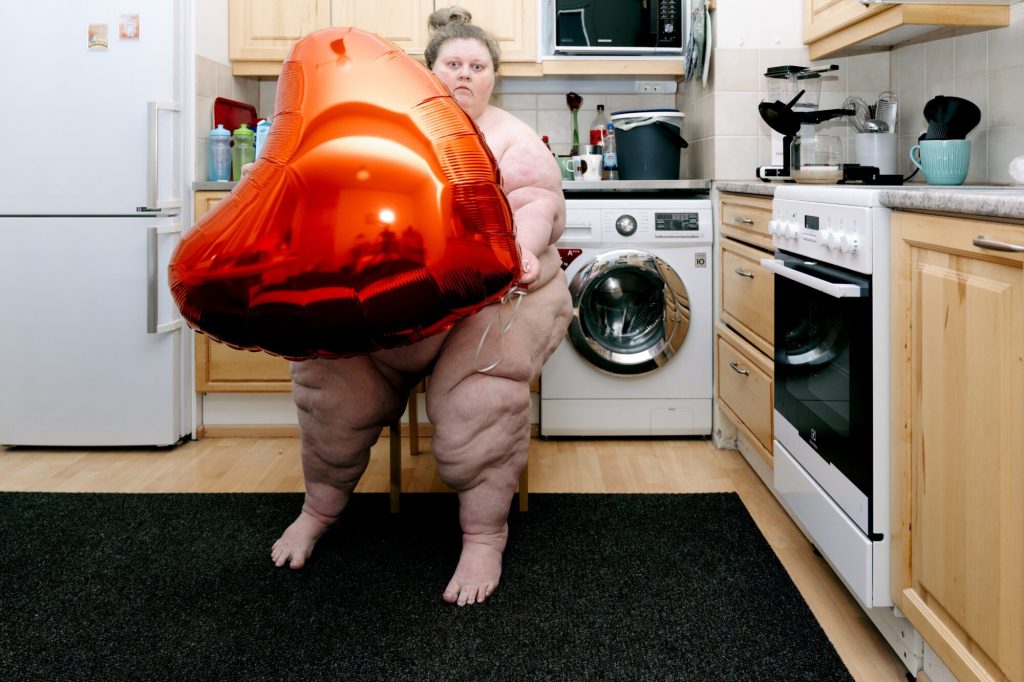
Iu Susiraja, Happy Valentine’s Day (big heart) (2022). Courtesy of the artist, Makasiini Contemporary and Nino Mier Gallery.
The inevitability of the viewer’s response is somewhat ironic given that one of the characteristics of the artist’s self-portraits is the lack of overt facial expression, with Susiraja frequently staring at the viewer from the photograph or video, his face impassive and outwardly emotionless. Susiraja has described being expressionless as a kind of “shield”, providing protection against what is truly intimate – one’s inner world – and ensuring that it does not influence what the viewer independently brings into the experience.
“Emotions on the face could be the key to something deeply disturbing. Disturbing for the viewer as well as for me,” the artist said. scer in people’s own territory.
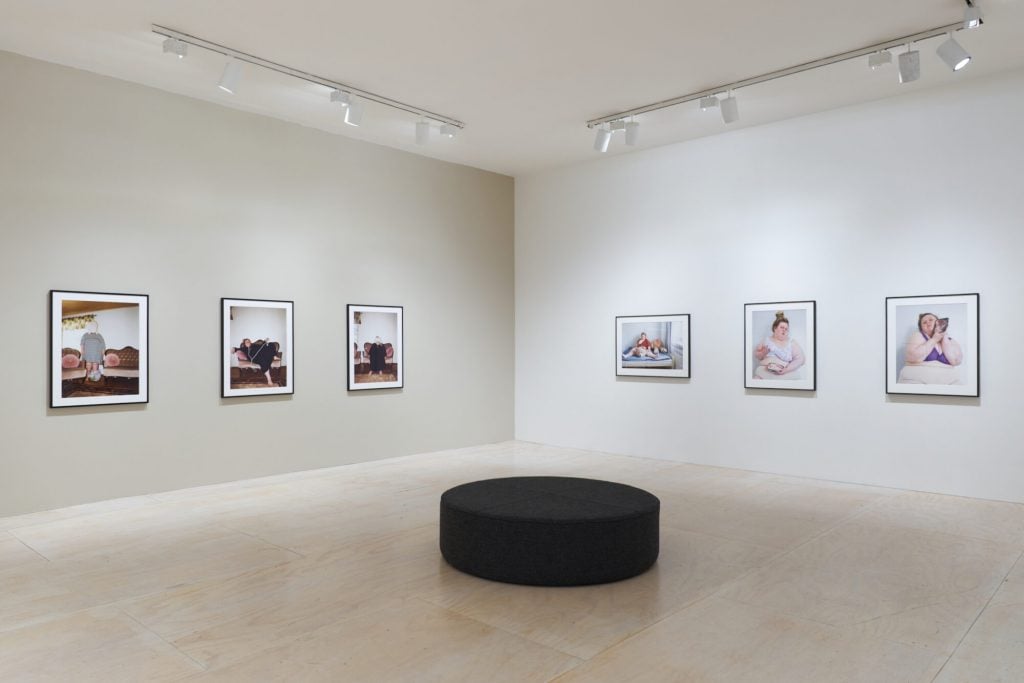
Installation view of “Iiu Susiraja: A Style Called a Dead Fish” (2023). Photo: Steven Paneccasio. Courtesy of MoMA PS1.
Originally and still based in Turku, Finland, Susiraja (b. 1975) first studied and worked in textile design before turning to photography. Currently, Susiraja is the subject of her first solo museum exhibition in the United States at MoMA PS1 in Long Island City, “Iiu Susiraja: A Style Called a Dead Fish”. The exhibit features over 50 photographs and videos from throughout her career starting in 2007, when she began photographing and filming herself. Tracing the evolution of her practice and the objects she chooses to use, the show highlights Susiraja’s unique and ironic humor, which often leaves the viewer unsettled and wondering if he is, in fact, in on the joke.
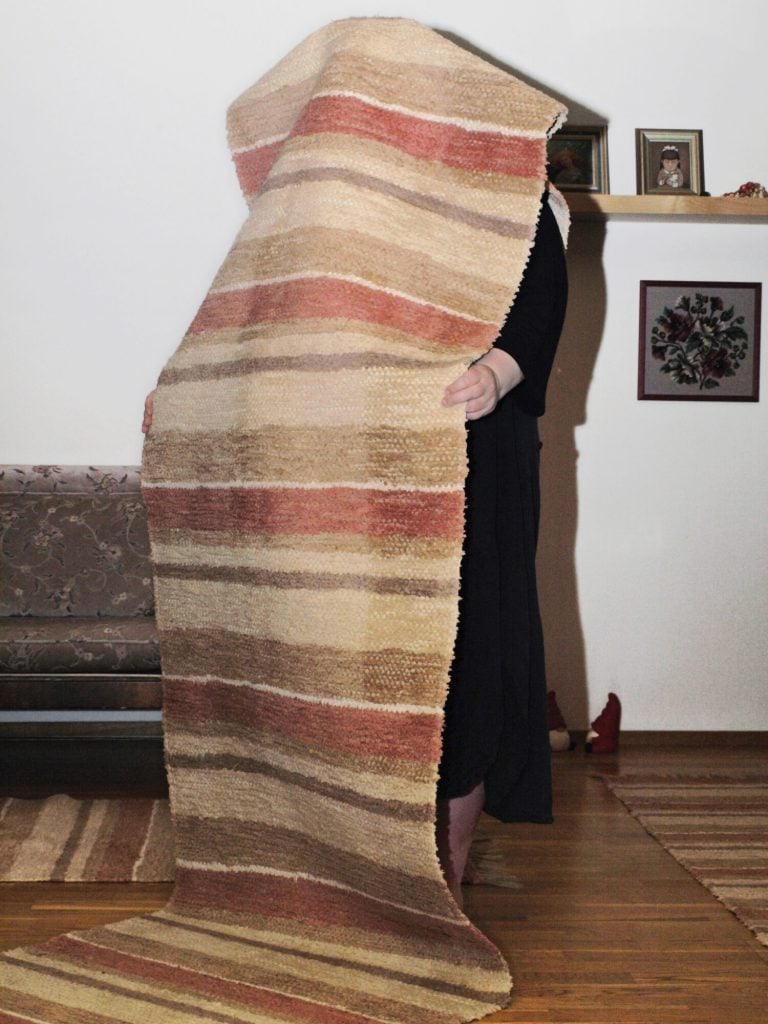
Iu Susiraja, Large-scale cleaning (2008). Courtesy of the artist, Makasiini Contemporary and Nino Mier Gallery.
Within the collection of works spanning over 15 years, one element that remains consistent is the frame. Susiraja takes all her images in her own house or that of her parents’ house nearby. The banality of these domestic settings can be seen as an extension of the ordinary objects with which it is represented; this is most evident in images such as Large-scale cleaning (2008), where a flat-weave runner, presumably a rug that exists organically in the home, is draped over the artist’s head. The title offers a glimpse into Susiraja’s dry wit, as the “large scale” could be interpreted as a reference to the overly long mat or Susiraja’s own body.
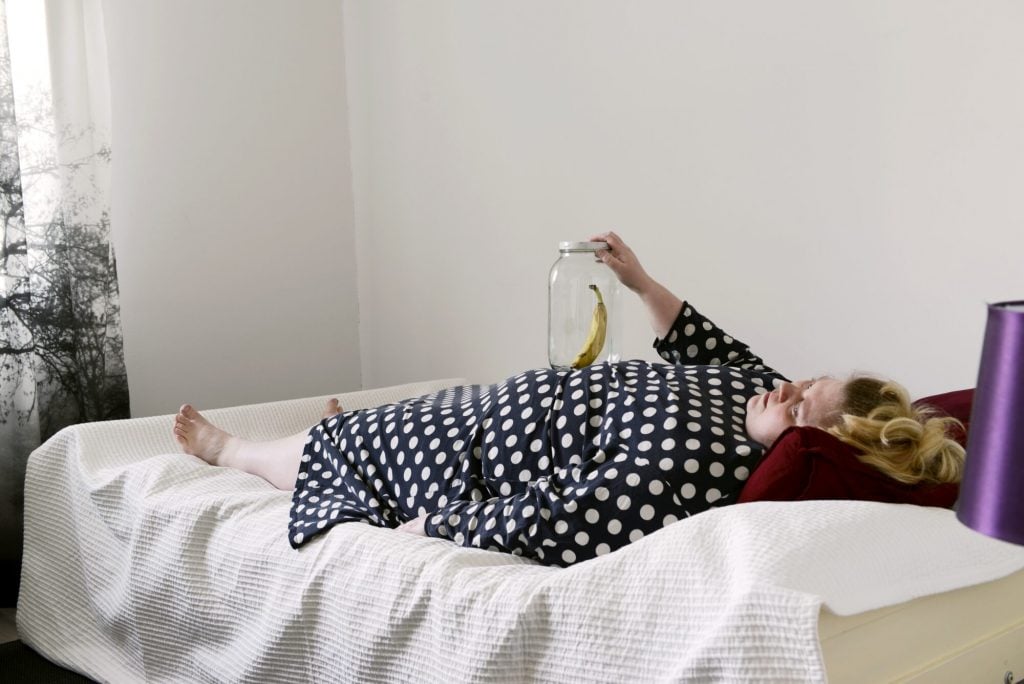
Iu Susiraja, Functional communication (2012). Courtesy of the artist, Makasiini Contemporary and Nino Mier Gallery.
The humor continues in works like Lucy (2010), where Susiraja sits with an electric candle tapped on her head, an irreverent and slapstick take on the crown of candles traditionally worn by an eldest daughter for Lucia Day in Scandinavia.
Somewhere else, Functional communication (2012) shows the artist lying on his back and looking at a banana in a jar. The mood of the picture is decidedly calm, thoughtful, emanating from loneliness. The title refers to a form of communication intended to express or respond to a need, but the artist communing alone with a fruit conveys both humor and sadness.
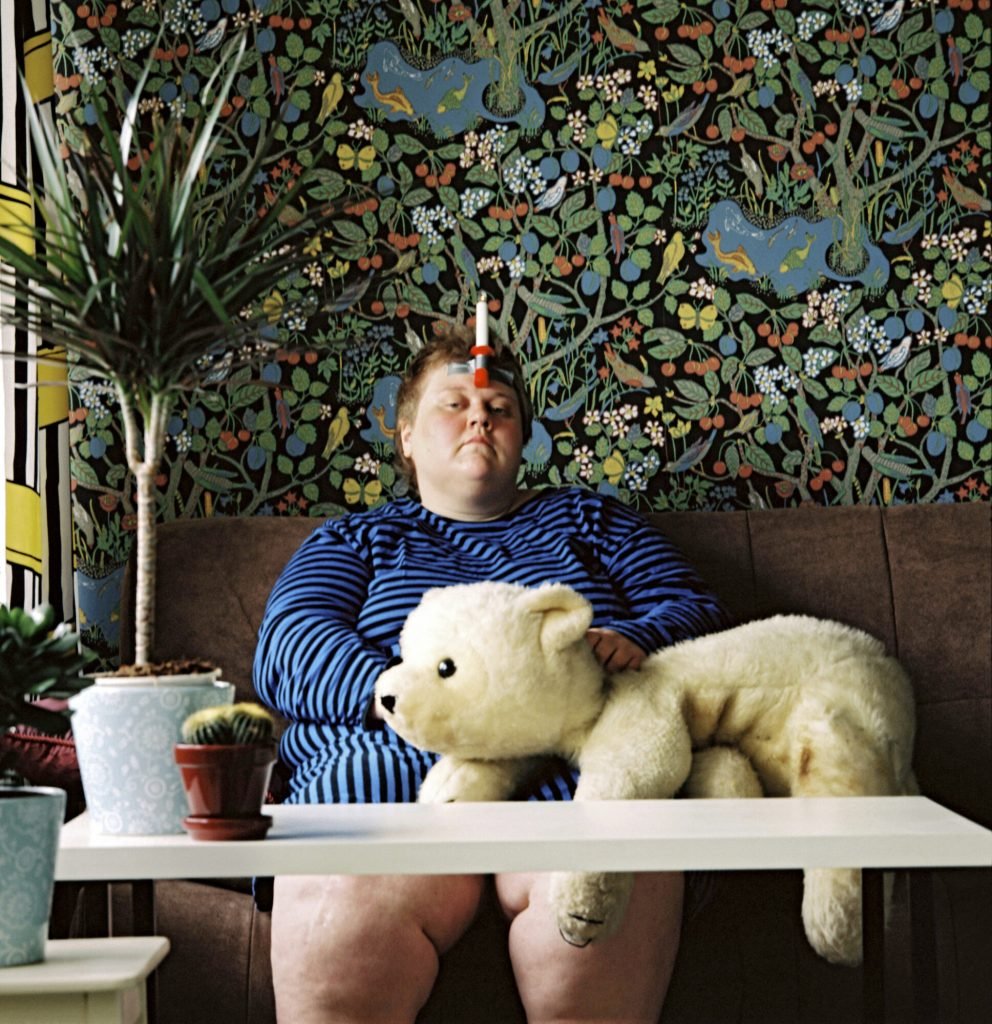
Iu Susiraja, Lucy (2010). Courtesy of the artist, Makasiini Contemporary and Nino Mier Gallery.
The choice of a treadmill or a fruit or an electric candle or any number of seemingly random everyday objects relays an artistic process that is almost as deadpan as the artist’s expression in his self-portraits. She first writes down a list of items she wants to use, collects them, and then takes the shot (plus, since she doesn’t use any kind of artificial studio lighting, a quick weather check is factored in to make sure there will be enough sunlight). When asked about the list that starts it all, the functionality and recognizability of the object are apparently the only real defining parameters.
Susiraja said, “It’s just a list, like a shopping list. The brain automatically blocks out objects that aren’t easily recognizable or don’t have a basic shape. An example is smoking. E-cigarettes are not a timeless, nor a classic. The pipe is not so commonly used. So the choice would be a regular cigarette.
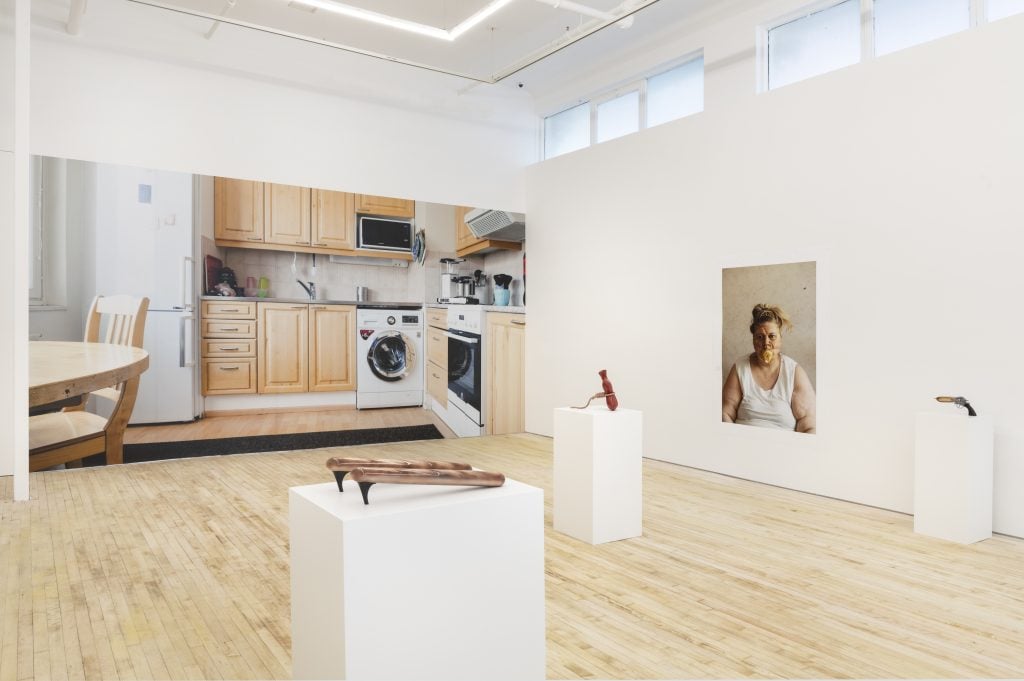
Installation view of “Iiu Susiraja: Hot Stuff” (2023). Photo: Adam Reich. Courtesy of the artist and Nino Mier Gallery.
Earlier this summer, New York’s Nino Mier Gallery presented ‘Hot Stuff’, a solo exhibition of Susiraja’s work featuring, like the exhibition at MoMA PS1, a range of self-portraits and videos staged by the artist, as well as a series of recent sculptural works replicating the everyday objects that frequent his photographs. The sculptures, in painted PLA plastic, highlight the importance of ordinary objects in his practice for their banality (whether in spite of or because of), and also illustrate Susiraja’s penchant for puns and dark humour. To lose weight (2022) features a hot water bottle with a slipknot in the middle, and heel bread (2023) represents a pair of heeled sticks of a pair of pumps.
From a purely categorical perspective, parallels could be drawn between the work of Susiraja and that of Cindy Sherman, who also works at the intersection of self-portraiture and staged photography. But unlike Sherman, Susiraja avoids any character building. Looking at one of Susiraja’s self-portraits, the viewer’s mind immediately tries to make sense of what is happening, searching for a narrative or internal logic that might explain what is happening and why various objects are in the frame. The different elements of Susiraja’s work don’t come together so easily and she resists playing a role or creating a character.
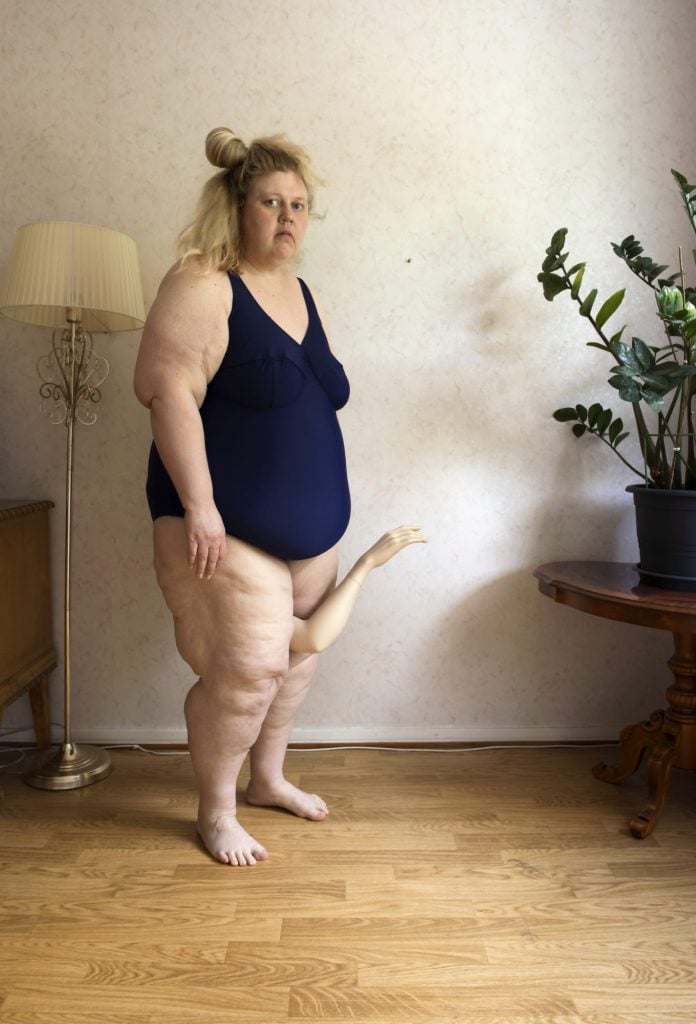
Iiu Susiraja, Handshake (2017). Courtesy of the artist, Makasiini Contemporary and Nino Mier Gallery.
“The roles are kind of tied to lying,” Susiraja said. “I was brought up to always try to tell the truth. And I love the truth! A lie is worthless and useless. A lie is fake money that can be thrown away. On the other hand, some keep bad money and let the damage spread. These people don’t know that truth includes the possibility of peace and freedom. The role, I think, makes symbolic reading difficult, because ‘role’ is a lie.
Truth and interconnectedness are essential elements of Susiraja’s photographic activities. Freed (often literally) from codified hierarchies of meaning or narrative, the interpretation of his work is a tide that oscillates between a shore of humor and wit, and a sea of poignant, sometimes even heartbreaking emotion. The tone and mood of the work, however, ultimately lies in the participation of the viewers, exploring how the artist’s strange but relatable scenes affect them on a deeply personal and psychological level.
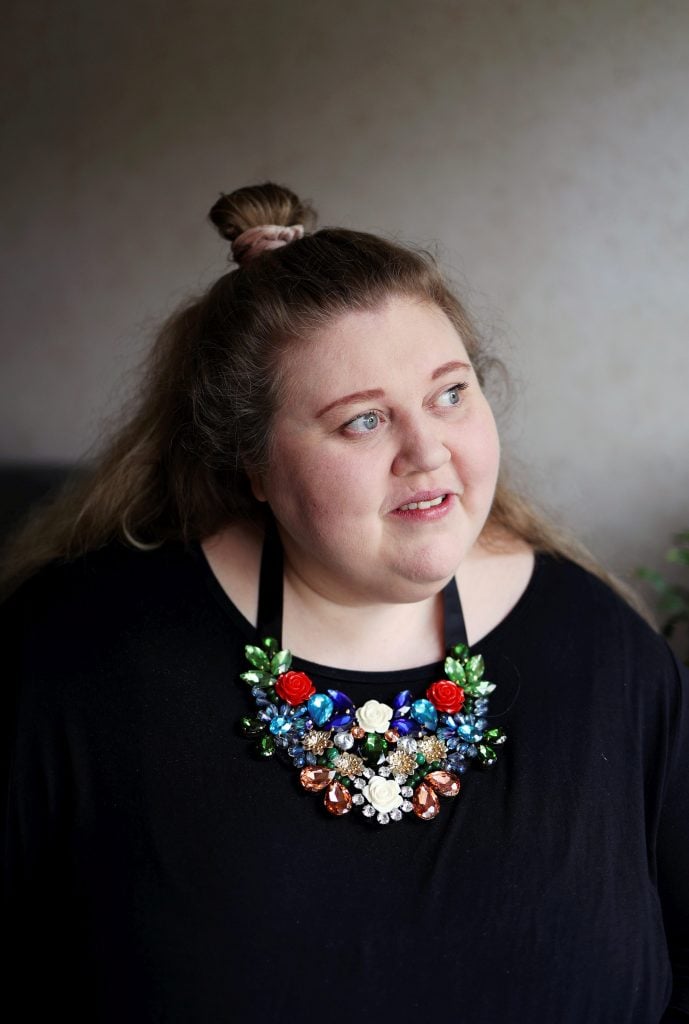
Iu Susiraja. Photo: Anni Savolainen. Courtesy of the artist.
“Iiu Susiraja: A Style Called Dead Fish” is on view at MoMA PS1, 22-25 Jackson Avenue, Queens, New York, until September 4.
Follow Artnet News on Facebook:
Want to stay one step ahead of the art world? Subscribe to our newsletter to receive breaking news, revealing interviews and incisive reviews that move the conversation forward.
